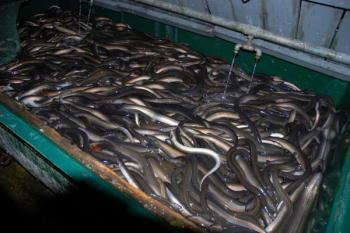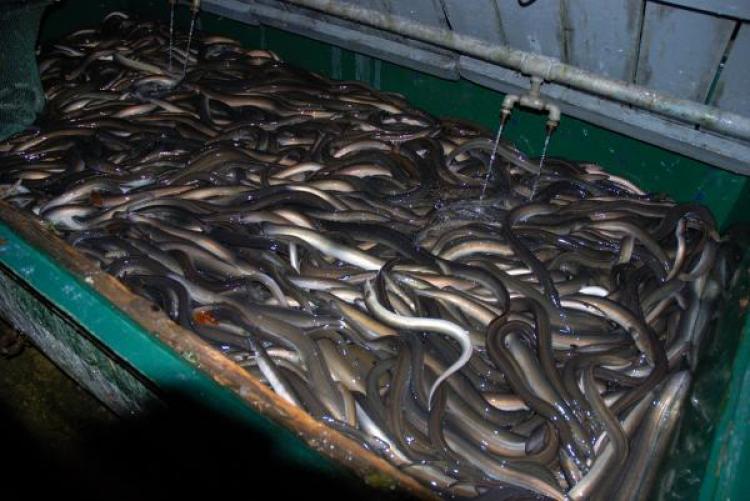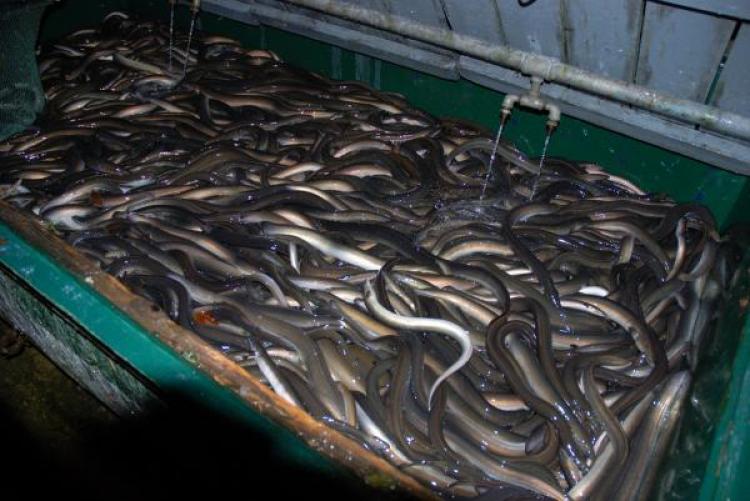For centuries, little had been known about European eels’ (Anguilla anguilla) 3,100-mile spawning marathon swim from the European coast back to their birthplace in the Sargasso Sea, south of Bermuda in the Atlantic Ocean.
Among all species of eels, European eels make the longest trip to their spawning site—up to 4,000 miles. In comparison, American eels move 1,900 to 2,500 miles, while Japanese eels move 600 miles.
“We know what’s happening when they are in fresh water. We also know about their larvae. After that they leave the coast of Europe, and from then on we don’t know anything. They sort of disappear,” said Dr. Kim Aarestrup, a senior researcher at the Technical University of Denmark’s National Institute of Aquatic Resources (DTU Aqua).
It takes about two to three years for the larvae to be carried to Europe by the Gulf Stream and North Atlantic Drift. Then in the autumn between their sixth and 30th birthdays, depending on the gender and growth conditions, the eels vanish for their one-way journey across the Atlantic Ocean to mate in their birthplace.
Along with his colleagues, Aarestrup tracked down the first 800 miles of their journey with recent advances in satellite technology, getting closer to a full understanding of the eels’ life cycle.
He said that they set small tags that register and store light, depth, and temperature to pop up to the surface on a specific date, transmitting data to a satellite.
For the last decade, the tags have been used on large ocean-dwelling animals such as sharks and tunas mostly. Even after the tags were miniaturized to 1.5 ounces recently, they are still too heavy for most eels.
Among the 100,000 European eels that the researchers looked at, only 22, each weighing about five pounds, five times heavier than a typical eel, were selected to bear the mission to carry the tags.
“We took the largest eels we could get,” said Aarestrup. “The incentive of getting the larger eels is that the tag nearly has no effect. … When we tag eels about this size, we are sure that they are female eels, because male eels barely exceed 40 to 50 centimeters (16 to 20 inches).”
After up to 120 days of observation, Aarestrup found that the migrating eels dive deep in the ocean during the day, probably to avoid predators and to delay maturation of their gonad, and then move back near the surface by night, rising and falling over 2,000 feet every day.
They also discovered that the eels traveled slower and more southward than they expected. The eels moved about 3 to 16 miles daily, much slower than the expected 22 miles per day to reach their destination for spring spawning. The scientists suggested that such southward behavior may allow them to catch a ride on the westward-moving currents that will accelerate them later.
Aarestrup said that the tagging is now continued in a new European Union-funded project (www.eeliad.com) lasting until 2012. Besides the satellite tags, which they will leave on the fish much longer—for up to a year after tagging, they are using a different technique, implanting much smaller general data storage tags in the large eels.
Aarestrup said that the new tags also record temperature and depth, but with a much lighter weight—about 0.2 ounce.
“The primary advantage is there’s absolutely no drag,” said Aarestrup.
The new tags do not have a satellite unit; once they detach from the fish, they float ashore. Therefore they are designed in bright colors for human beings to find and return to the researchers for a reward.
According to Aarestrup, the recruitment of European eel larvae, a critically endangered species, is down to below 5 percent, in areas below 1 percent of the recruitment 40 years ago. The need to completely understand the eel life cycle is more necessary than ever to prevent their extinction.
Aarestrup said that European eels nowadays face being mashed by hydropower plants, fishing, introduced parasites from Japanese eels, drainage that ruins their habitat, blockage of their migration route, and lethal toxicants from pollution.
To see Dr. Kim Aarestrup’s research paper, please visit
http://www.sciencemag.org/cgi/content/abstract/325/5948/1660
The Mystery of European Eels’ 3,100-Mile Migration
Among all species of eels, European eels make the longest trip to their spawning site—up to 4,000 miles.

BIGGEST EEL CONTEST: Dr. Kim Aarestrup and his colleagues searched among more than 100,000 live eels caught by Irish fishermen to find 22 large eels for tagging. Kim Aarestrup/DTU Aqua
|Updated:





